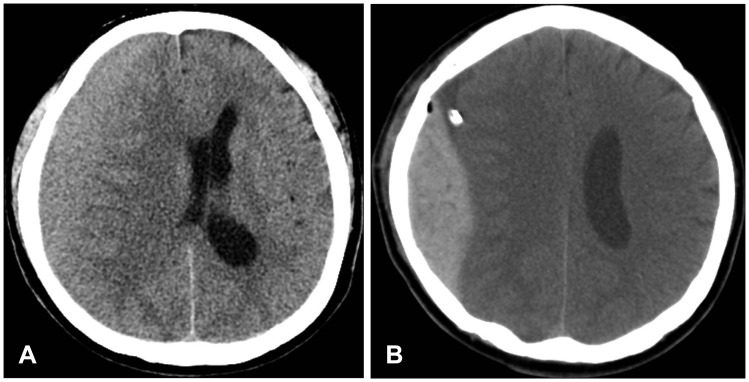Korean J Neurotrauma.
2016 Oct;12(2):94-100. 10.13004/kjnt.2016.12.2.94.
Correlation between Head Trauma and Outcome of Chronic Subdural Hematoma
- Affiliations
-
- 1Department of Neurosurgery, Ulsan University Hospital, University of Ulsan College of Medicine, Ulsan, Korea. kist1817@gmail.com
- KMID: 2356780
- DOI: http://doi.org/10.13004/kjnt.2016.12.2.94
Abstract
OBJECTIVE
Our study examined the prognostic factors involved in the outcome of patients with chronic subdural hematoma (CSDH) who had undergone burr hole drainage procedures, and investigated the association between outcome and traumatic head injury. In addition, we explored factors related to recurrence.
METHODS
This study enrolled 238 patients with CSDH who had undergone burr hole drainage. Patients with history of head injury were categorized into the head trauma group and were compared with the no head trauma group. Outcome was considered good when modified Rankin Scale scores improved from admission to discharge and the final follow-up.
RESULTS
Among 238 patients, 127 (53.4%) were included in the head trauma group. One hundred thirty-three (55.9%) patients demonstrated good outcome at discharge, and 171 (71.8%) patients demonstrated good outcome at the final follow-up. None of the factors examined was significantly correlated with good outcome at discharge. However, only history of head injury (p=0.033, odds ratio 0.511, 95% confidence interval 0.277-0.946) was significantly correlated with poor outcome at long-term follow-up. Recurrence occurred in 20 (8.4%) cases in the total cohort and 11 (55%) patients in the head trauma group.
CONCLUSION
History of head trauma is correlated with poor outcome at long-term follow-up in CSDH patients having undergone burr hole drainage. Therefore, CSDH patients with history of head injury are susceptible to poor outcome, warranting more careful evaluation and treatment after burr hole drainage.
MeSH Terms
Figure
Reference
-
1. Amirjamshidi A, Abouzari M, Eftekhar B, Rashidi A, Rezaii J, Esfandiari K, et al. Outcomes and recurrence rates in chronic subdural haematoma. Br J Neurosurg. 2007; 21:272–275. PMID: 17612917.
Article2. Bigler ED. Neuropathology of mild traumatic brain injury: correlation to neurocognitive and neurobehavioral findings. In : Kobeissy FH, editor. Brain neurotrauma: molecular, neuropsychological, and rehabilitation aspects. Boca Raton, FL: CRC Press/Taylor & Francis;2015. p. 433–450.3. De Bonis P, Trevisi G, de Waure C, Sferrazza A, Volpe M, Pompucci A, et al. Antiplatelet/anticoagulant agents and chronic subdural hematoma in the elderly. PLoS One. 2013; 8:e68732. PMID: 23874740.
Article4. Delgado PD, Cogolludo FJ, Mateo O, Cancela P, Garcia R, Carrillo R. Early prognosis in chronic subdural hematomas. Multivariate analysis of 137 cases. Rev Neurol. 2000; 30:811–817. PMID: 10870192.5. Fukuhara T, Gotoh M, Asari S, Ohmoto T, Akioka T. The relationship between brain surface elastance and brain reexpansion after evacuation of chronic subdural hematoma. Surg Neurol. 1996; 45:570–574. PMID: 8638244.
Article6. Ishibashi A, Yokokura Y, Adachi H. A comparative study of treatments for chronic subdural hematoma: burr hole drainage versus burr hole drainage with irrigation. Kurume Med J. 2011; 58:35–39. PMID: 22027196.
Article7. Kageyama H, Toyooka T, Tsuzuki N, Oka K. Nonsurgical treatment of chronic subdural hematoma with tranexamic acid. J Neurosurg. 2013; 119:332–337. PMID: 23641825.
Article8. Kolias AG, Chari A, Santarius T, Hutchinson PJ. Chronic subdural haematoma: modern management and emerging therapies. Nat Rev Neurol. 2014; 10:570–578. PMID: 25224156.
Article9. Lee JJ, Won Y, Yang T, Kim S, Choi CS, Yang J. Risk factors of chronic subdural hematoma progression after conservative management of cases with initially acute subdural hematoma. Korean J Neurotrauma. 2015; 11:52–57. PMID: 27169065.
Article10. Lee KS. Chronic subdural hematoma in the aged, trauma or degeneration? J Korean Neurosurg Soc. 2016; 59:1–5. PMID: 26885279.
Article11. Liu W, Bakker NA, Groen RJ. Chronic subdural hematoma: a systematic review and meta-analysis of surgical procedures. J Neurosurg. 2014; 121:665–673. PMID: 24995782.
Article12. Miranda LB, Braxton E, Hobbs J, Quigley MR. Chronic subdural hematoma in the elderly: not a benign disease. J Neurosurg. 2011; 114:72–76. PMID: 20868215.
Article13. Mu W, Catenaccio E, Lipton ML. Neuroimaging in blast-related mild traumatic brain injury. J Head Trauma Rehabil. DOI: 10.1097/htr.0000000000000213. [epub ahead of print March 28, 2016].
Article14. Ro HW, Park SK, Jang DK, Yoon WS, Jang KS, Han YM. Preoperative predictive factors for surgical and functional outcomes in chronic subdural hematoma. Acta Neurochir (Wien). 2016; 158:135–139. PMID: 26602235.
Article15. Talavage TM, Nauman EA, Leverenz LJ. The role of medical imaging in the recharacterization of mild traumatic brain injury using youth sports as a laboratory. Front Neurol. 2015; 6:273. PMID: 26834695.
Article16. Toth A. Magnetic resonance imaging application in the area of mild and acute traumatic brain injury: implications for diagnostic markers?. In : Kobeissy FH, editor. Brain neurotrauma: molecular, neuropsychological, and rehabilitation aspects. Boca Raton, FL: CRC Press/Taylor & Francis;2015. p. 329–340.17. van Havenbergh T, van Calenbergh F, Goffin J, Plets C. Outcome of chronic subdural haematoma: analysis of prognostic factors. Br J Neurosurg. 1996; 10:35–39. PMID: 8672256.18. Villagrasa J, Prat R, Díaz JF, Comuñas F. Analysis of prognostic factors in adults with chronic subdural hematoma. Neurologia. 1998; 13:120–124. PMID: 9608218.19. Wylie GR, Freeman K, Thomas A, Shpaner M, M OK, Watts R, et al. Cognitive improvement after mild traumatic brain injury measured with functional neuroimaging during the acute period. PLoS One. 2015; 10:e0126110. PMID: 25962067.
Article
- Full Text Links
- Actions
-
Cited
- CITED
-
- Close
- Share
- Similar articles
-
- Chronic Subdural Hematoma Due to Cumulative Trauma to the Head
- Arachnoid Cyst with Spontaneous Intracystic Hemorrhage and Chronic Subdural Hematoma
- Chronic Subdural Hematoma Superimposed on Posttraumatic Subdural Hygroma: A Report of Three Cases
- Intraoperative Development of Contralateral Subdural Hematoma during Evacuation of Acute Subdural Hematoma: Case Report
- Prognostic Factors of Chronic Subdural Hematoma


